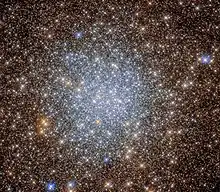| NGC 6569 | |
|---|---|
 Hubble Space Telescope image of NGC 6569 | |
| Observation data (J2000 epoch) | |
| Class | VIII |
| Constellation | Sagittarius |
| Right ascension | 18h 13m 38.88s[1] |
| Declination | −31° 49′ 35.2″[1] |
| Distance | 35.5 kly (10.9 kpc)[2] |
| Apparent magnitude (V) | 9.47[1] |
| Apparent dimensions (V) | 7.0′ × 7.0′[2] |
| Physical characteristics | |
| Metallicity | = -0.76[3] dex |
| Other designations | GCl 91, ESO 456-77, VDBH 260[1] |
NGC 6569 is a globular cluster in the constellation Sagittarius. It has an apparent magnitude of about 9.5,[1] and an apparent diameter of 7 arc minutes, and class VIII with stars of magnitude 15 and dimmer.[2] It is about 2 degrees south east of Gamma2 Sagittarii. The globular cluster was discovered in 1784 by the astronomer William Herschel with his 18.7-inch telescope and was catalogued later in the New General Catalogue.[4]
References
- 1 2 3 4 5 "NGC 6569". SIMBAD. Centre de données astronomiques de Strasbourg. Retrieved 13 February 2017.
- 1 2 3 "NGC 5634". Retrieved 7 January 2016.
- ↑ William E. Harris. "Catalog of Parameters for Milky Way Globular Clusters". Retrieved 13 February 2017.
- ↑ Courtney Seligman. "New General Catalog Objects: NGC 6550 - 6599". Retrieved 13 February 2017.
External links
 Media related to NGC 6569 at Wikimedia Commons
Media related to NGC 6569 at Wikimedia Commons
This article is issued from Wikipedia. The text is licensed under Creative Commons - Attribution - Sharealike. Additional terms may apply for the media files.